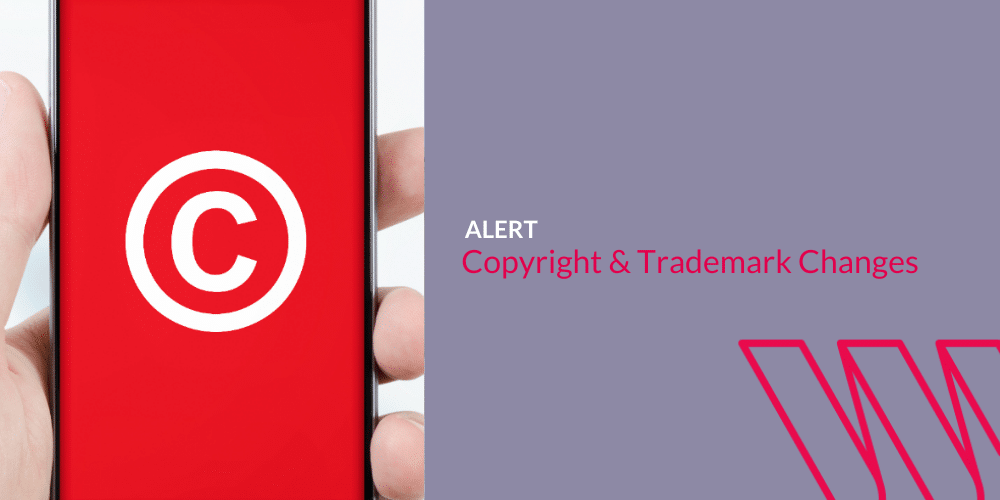The most recent COVID-19 relief act contains provisions that modify certain aspects of copyright and trademark law. Some of those changes are described below.
Copyright
Copyright Claims Board
The Act establishes a Copyright Claims Board, which is a tribunal within the Copyright Office. The Board consists of three Copyright Claims Officers, who are attorneys with substantial copyright experience. The Board handles claims for infringement involving limited damages, claims for declarations of noninfringement, claims that a party knowingly submitted a false takedown notice, and related counterclaims. Awards for infringement are limited to a maximum of $15,000 per infringed work and $30,000 total for all works. The respondent can opt out of the proceeding. Parties that choose to proceed before the Board waive their right to formal motion practice and a jury trial. Parties bear their own attorneys’ fees and costs, except when there is bad faith misconduct. Fee awards are limited to $5,000, absent extraordinary circumstances.
Decisions must be written and contain factual findings and legal conclusions. Decisions may not be cited or relied upon as legal precedent in any other proceeding, including other actions before the Board.
Parties can challenge the Board’s decision by seeking reconsideration by the Board, and if denied, review by the Register of Copyrights. Review can be sought in federal district court only on the grounds that:
- The decision was the result of fraud, corruption or other misconduct,
- The tribunal exceeded its authority or failed to render a final determination, or
- If the decision was based on a default or failure to prosecute, the default or failure was excusable.
Protecting Lawful Streaming Act
Under prior law, the unauthorized reproduction and distribution of copyrighted materials could be charged as a felony, but the live streaming of such material was only a misdemeanor. The Act eliminates that disparity by providing that the unauthorized live streaming of copyrighted works can be charged as a felony as well. The Act is not intended to apply to individuals, but only to digital transmission services which “willfully, and for purposes of commercial advantage or private financial gain:”
- Are primarily designed or provided for the purpose of streaming copyrighted works without the authority of the copyright owner or the law,
- Have no commercially significant purpose or use other than to stream copyrighted works without the authority of the copyright owner or the law, or
- Are intentionally marketed or directed to promote their use in streaming copyrighted works without the authority of the copyright owner or the law.
Trademark
Presumption of Irreparable Harm
The Act establishes a rebuttable presumption of irreparable harm in favor of the trademark owner:
- At the preliminary injunction stage where the owner demonstrates a likelihood of success on the merits, and
- After a Lanham Act violation has been found, for the purposes of determining whether a permanent injunction should be issued.
Ex Parte Expungement Procedure
The Act allows a third party to file a petition before the PTO to expunge a trademark registration on the ground that the mark has never been used in commerce or in connection with some or all of the goods or services recited in the registration. Standing is not required to file such a petition. A petition can be filed beginning three years after the date of registration. The petition must describe the investigation that was undertaken to determine whether the mark was used. After a petition is filed, the examiner determines whether the petition sets forth a prima facie case. If the examiner determines that a prima facie case has been made, notice will be provided to the registrant, who will have the opportunity to produce evidence of use or excusable neglect. The examiner then decides whether to expunge the registration for some or all of the goods or services listed in the registration.
Ex Parte Reexamination Procedure
The ex parte reexamination procedure is similar to the ex parte expungement procedure. Unlike ex parte expungement proceedings—where the issue is whether the goods or services were ever offered under the mark—the issue in an ex parte reexamination proceeding is whether the goods or services were offered under the mark on or before the “relevant date.” For a use-based application, the relevant date is the date the application was filed. For an intent-to-use application, the relevant date is the date identified in the statement of use. An ex parte reexamination proceeding can be filed at any time within the first five years after the registration date.
Decisions in both types of ex parte proceedings can be appealed to the Trademark Trial and Appeal Board, and then to the Federal Circuit. The ex parte procedures will become available one year after the Act was signed into law, after the Director implements regulations establishing them.


